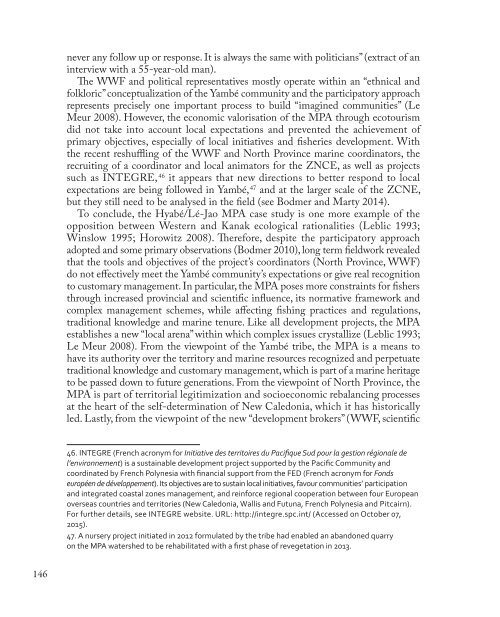Fisheries in the Pacific
Fisheries_in_the_Pacific
Fisheries_in_the_Pacific
Create successful ePaper yourself
Turn your PDF publications into a flip-book with our unique Google optimized e-Paper software.
never any follow up or response. It is always <strong>the</strong> same with politicians” (extract of an<br />
<strong>in</strong>terview with a 55-year-old man).<br />
The WWF and political representatives mostly operate with<strong>in</strong> an “ethnical and<br />
folkloric” conceptualization of <strong>the</strong> Yambé community and <strong>the</strong> participatory approach<br />
represents precisely one important process to build “imag<strong>in</strong>ed communities” (Le<br />
Meur 2008). However, <strong>the</strong> economic valorisation of <strong>the</strong> MPA through ecotourism<br />
did not take <strong>in</strong>to account local expectations and prevented <strong>the</strong> achievement of<br />
primary objectives, especially of local <strong>in</strong>itiatives and fisheries development. With<br />
<strong>the</strong> recent reshuffl<strong>in</strong>g of <strong>the</strong> WWF and North Prov<strong>in</strong>ce mar<strong>in</strong>e coord<strong>in</strong>ators, <strong>the</strong><br />
recruit<strong>in</strong>g of a coord<strong>in</strong>ator and local animators for <strong>the</strong> ZNCE, as well as projects<br />
such as INTEGRE, 46 it appears that new directions to better respond to local<br />
expectations are be<strong>in</strong>g followed <strong>in</strong> Yambé, 47 and at <strong>the</strong> larger scale of <strong>the</strong> ZCNE,<br />
but <strong>the</strong>y still need to be analysed <strong>in</strong> <strong>the</strong> field (see Bodmer and Marty 2014).<br />
To conclude, <strong>the</strong> Hyabé/Lé-Jao MPA case study is one more example of <strong>the</strong><br />
opposition between Western and Kanak ecological rationalities (Leblic 1993;<br />
W<strong>in</strong>slow 1995; Horowitz 2008). Therefore, despite <strong>the</strong> participatory approach<br />
adopted and some primary observations (Bodmer 2010), long term fieldwork revealed<br />
that <strong>the</strong> tools and objectives of <strong>the</strong> project’s coord<strong>in</strong>ators (North Prov<strong>in</strong>ce, WWF)<br />
do not effectively meet <strong>the</strong> Yambé community’s expectations or give real recognition<br />
to customary management. In particular, <strong>the</strong> MPA poses more constra<strong>in</strong>ts for fishers<br />
through <strong>in</strong>creased prov<strong>in</strong>cial and scientific <strong>in</strong>fluence, its normative framework and<br />
complex management schemes, while affect<strong>in</strong>g fish<strong>in</strong>g practices and regulations,<br />
traditional knowledge and mar<strong>in</strong>e tenure. Like all development projects, <strong>the</strong> MPA<br />
establishes a new “local arena” with<strong>in</strong> which complex issues crystallize (Leblic 1993;<br />
Le Meur 2008). From <strong>the</strong> viewpo<strong>in</strong>t of <strong>the</strong> Yambé tribe, <strong>the</strong> MPA is a means to<br />
have its authority over <strong>the</strong> territory and mar<strong>in</strong>e resources recognized and perpetuate<br />
traditional knowledge and customary management, which is part of a mar<strong>in</strong>e heritage<br />
to be passed down to future generations. From <strong>the</strong> viewpo<strong>in</strong>t of North Prov<strong>in</strong>ce, <strong>the</strong><br />
MPA is part of territorial legitimization and socioeconomic rebalanc<strong>in</strong>g processes<br />
at <strong>the</strong> heart of <strong>the</strong> self-determ<strong>in</strong>ation of New Caledonia, which it has historically<br />
led. Lastly, from <strong>the</strong> viewpo<strong>in</strong>t of <strong>the</strong> new “development brokers” (WWF, scientific<br />
46. INTEGRE (French acronym for Initiative des territoires du Pacifique Sud pour la gestion régionale de<br />
l’environnement) is a susta<strong>in</strong>able development project supported by <strong>the</strong> <strong>Pacific</strong> Community and<br />
coord<strong>in</strong>ated by French Polynesia with f<strong>in</strong>ancial support from <strong>the</strong> FED (French acronym for Fonds<br />
européen de développement). Its objectives are to susta<strong>in</strong> local <strong>in</strong>itiatives, favour communities’ participation<br />
and <strong>in</strong>tegrated coastal zones management, and re<strong>in</strong>force regional cooperation between four European<br />
overseas countries and territories (New Caledonia, Wallis and Futuna, French Polynesia and Pitcairn).<br />
For fur<strong>the</strong>r details, see INTEGRE website. URL: http://<strong>in</strong>tegre.spc.<strong>in</strong>t/ (Accessed on October 07,<br />
2015).<br />
47. A nursery project <strong>in</strong>itiated <strong>in</strong> 2012 formulated by <strong>the</strong> tribe had enabled an abandoned quarry<br />
on <strong>the</strong> MPA watershed to be rehabilitated with a first phase of revegetation <strong>in</strong> 2013.<br />
146


